Major X1.5 solar flare erupts — the first X-class flare of Solar Cycle 25
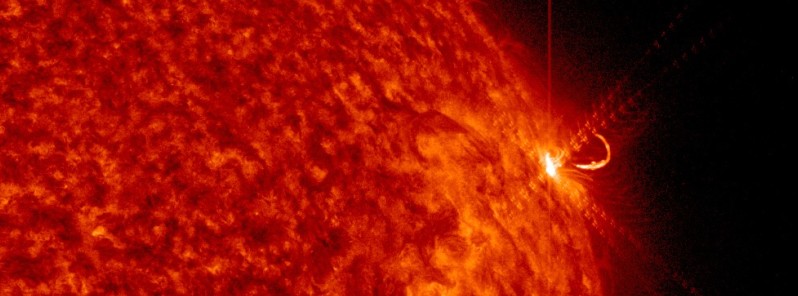
A major solar flare measuring X1.5 at its peak erupted on the Sun's NW limb — most likely from the newly-formed Active Region 2838 — on July 3, 2021, producing R3 – Strong radio blackout. The event started at 14:18, peaked at 14:29, and ended at 14:34 UTC. This is the first X-class solar flare of Solar Cycle 25 and the first since September 2017.
A Type II Radio emission with an estimated velocity of 375 km/s was registered at 14:37 UTC. Type II emissions occur in association with eruptions on the sun and typically indicate a coronal mass ejection is associated with a flare event.
While this region does not favor Earth-directed coronal mass ejections, the eruption produced R3 – Strong radio blackout — wide area blackout of HF radio communication, loss of radio contact for about an hour on the sunlit side of Earth.
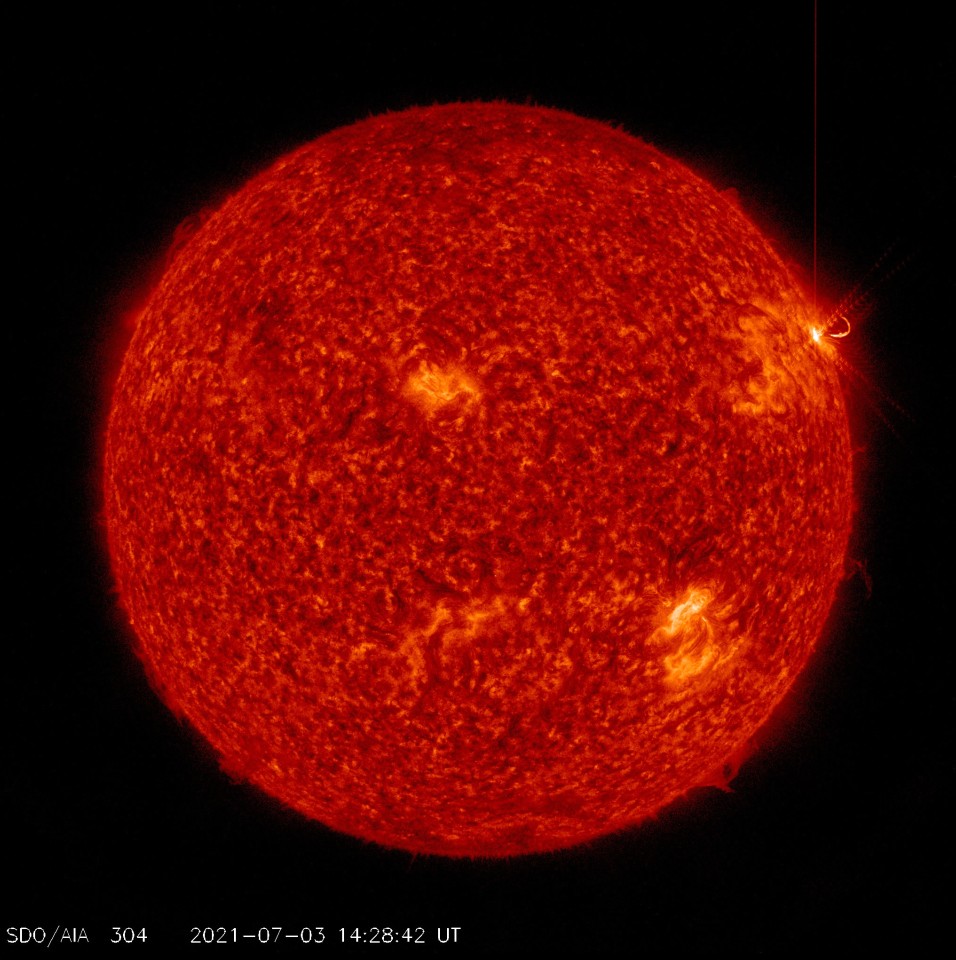
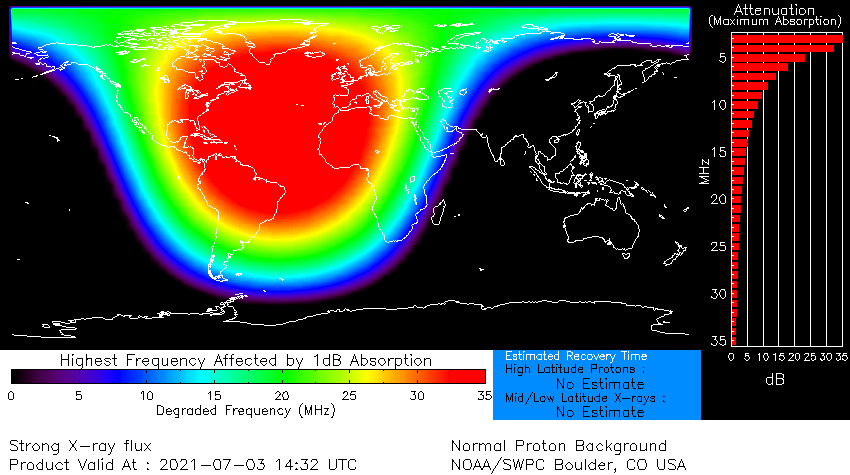
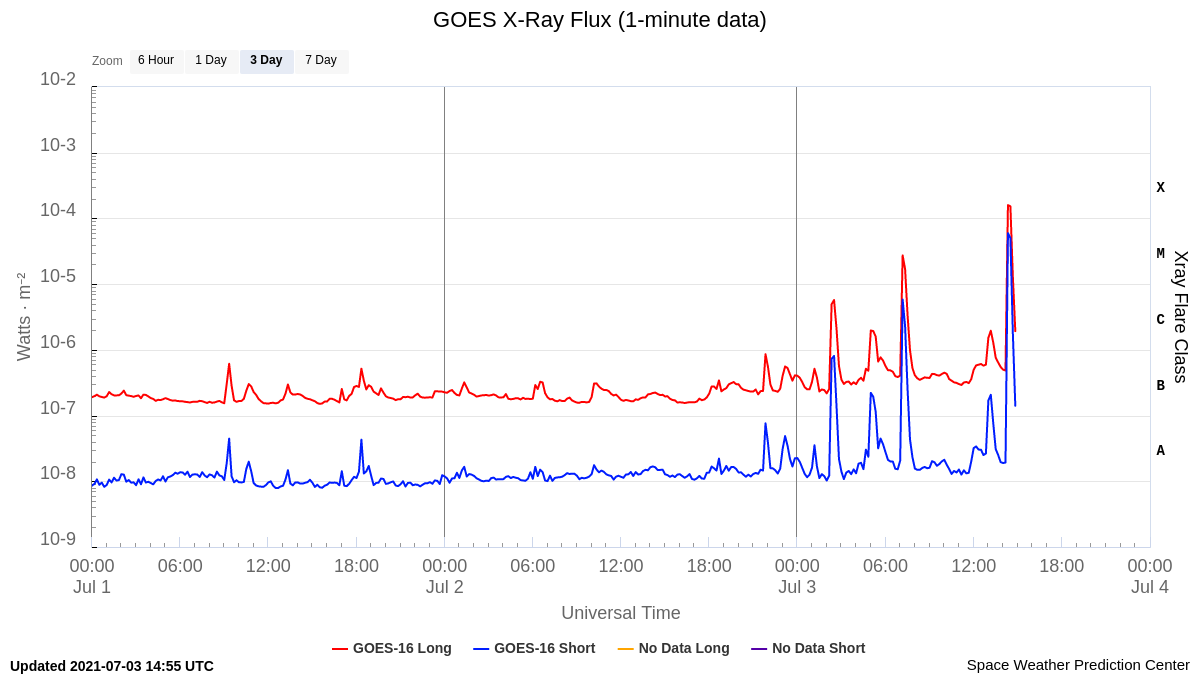
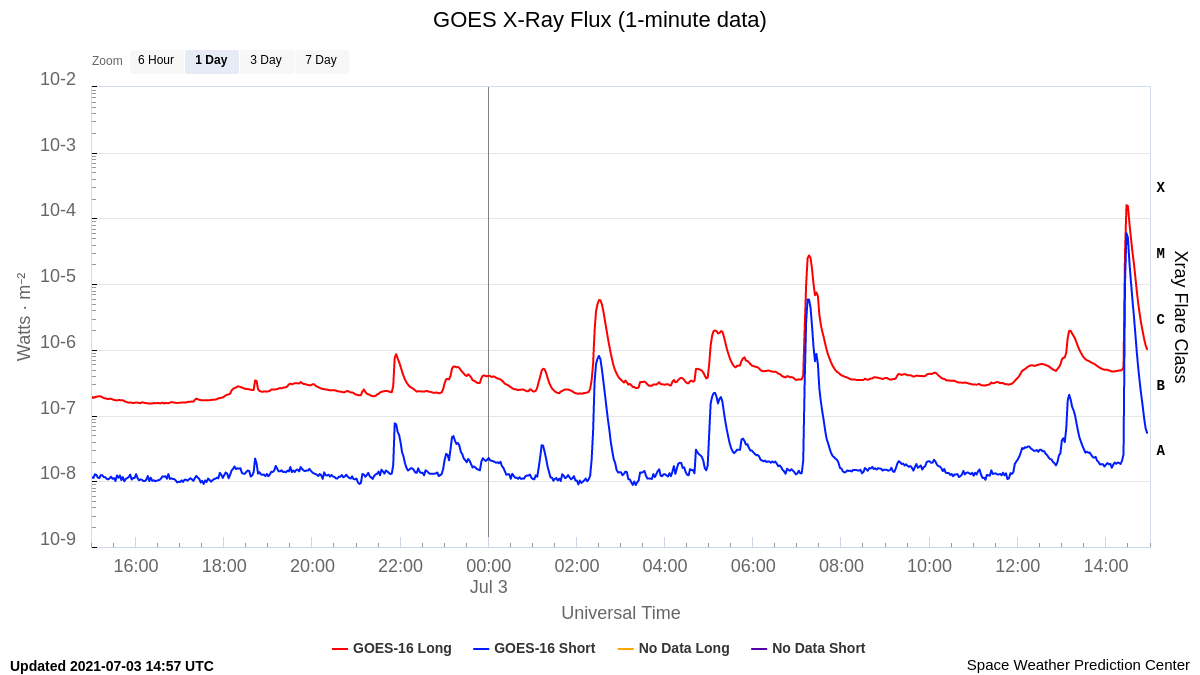
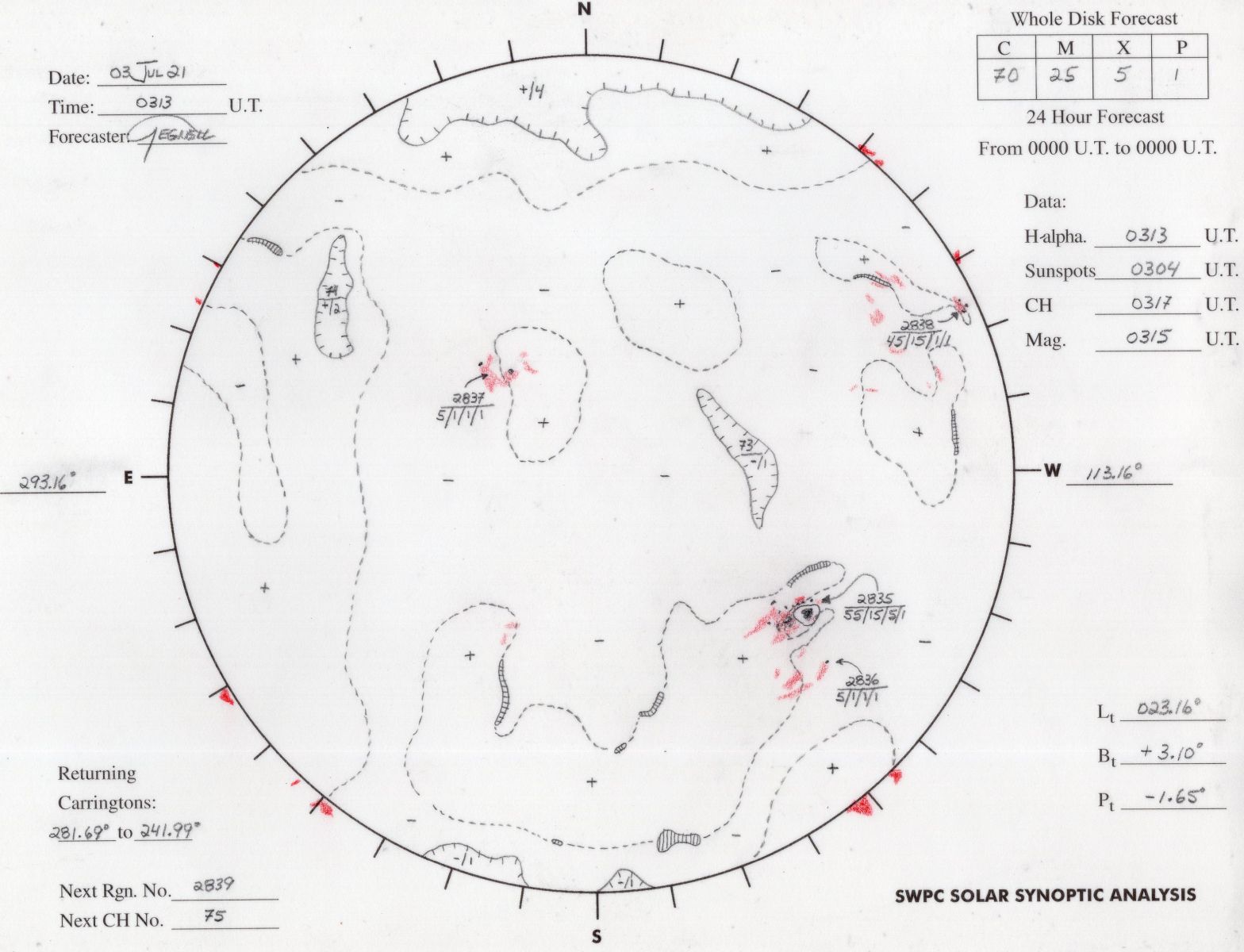
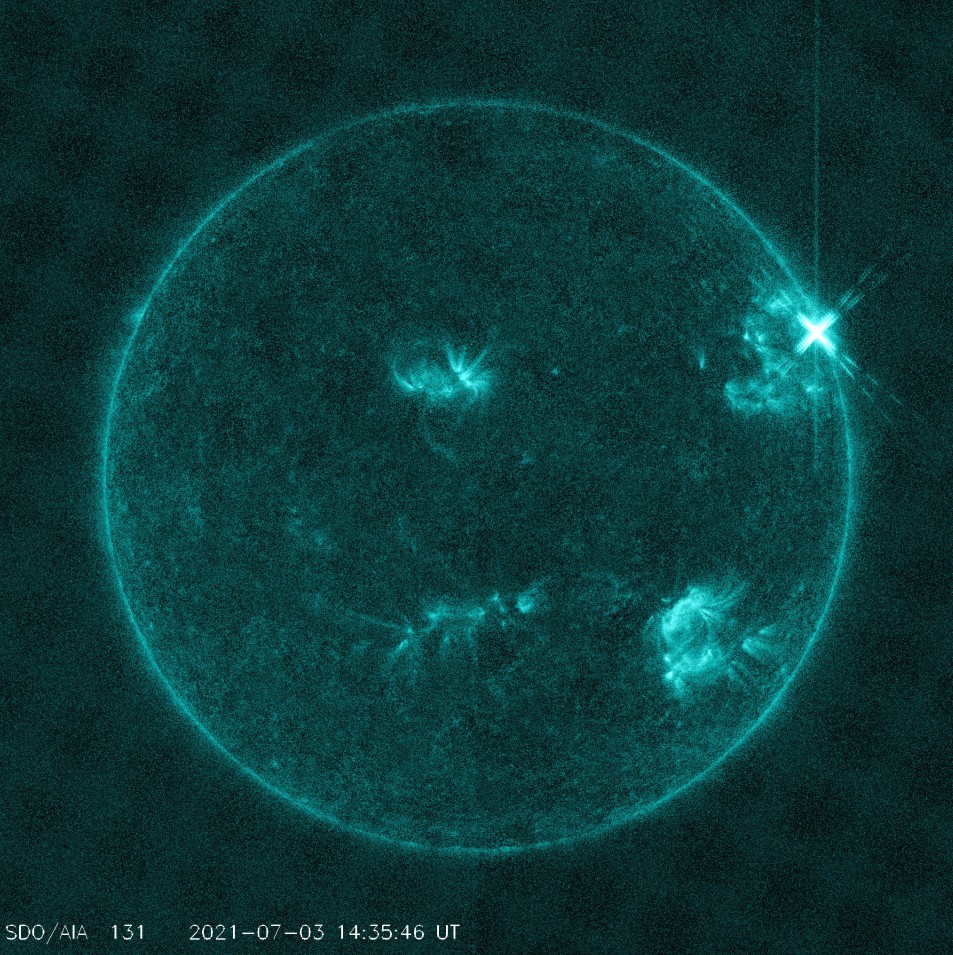
The same region produced a moderately strong M2.7 solar flare at 07:17 UTC today.
Solar activity was very low on July 2.
B-class flaring was observed from Regions 2836 (S26W36, Axx/alpha) and 2837 (N17E15, Dro/beta). Slight decay was observed in Region 2836 and the trailing spots of Region 2835 (S18W29, Dkc/beta-delta). Region 2835 developed a weak delta as the main penumbral area connected with some of the intermediate spots while Region 2837 grew slightly.
Other activity included an eruptive prominence observed off the NW limb in GOES SUVI 304 imagery beginning at 14:01 UTC. An associated CME was observed in SOHO LASCO C2 imagery beginning at 15:36 UTC.
"Modeling of this CME will commence as further imagery becomes available. However, due to its location beyond the NW limb, it will likely not have a geoeffective component," SWPC forecasters noted.
Solar wind parameters were slightly enhanced on July 2. Wind speed ranged from 414 – 499 km/s while the total field was between 3 – 7 nT. Phi showed a boundary crossing into a negative sector at 14:18 UTC.
Solar activity is likely to be low with a slight chance for M-class (R1-R2, Minor-Moderate) radio blackouts through July 5 due to the magnetic complexity of Region 2835.
While we still might see some action from Region 2838, it will soon start its farside rotation and return back to Earth-view in about 2 weeks.
Featured image: X1.5 solar flare on July 3, 2021. Credit: NASA SDO/AIA 304

What shall follow? I am absolutely certain the coming solar maximum will produce the biggest solar flares ever recorded.
Fibonacci, in physical reality and not according to mainstream astrophysics, the Sun is variable star, just like all stars. In fact, this fact is overwhelming obvious on a short and long time scales. If one looks to the activity of all the previous solar cycles, he or she will find many differences among those cycles. And, it is well known that there were times when the solar activity decreases enormously and for decades (the so-called grand solar minima), and there are times when the maximum activity of the Sun is far higher than the average. However, the activity would become more extreme when the intensity of the magnetic field of the Sun approaches its maximum value. And, the maximum value of the Sun’s magnetic field is reached when the Sun reaches its highest position in the galaxy. Keep in mind that the Sun is not only rotating around the galactic core but also spiraling up and down. In other words, it is getting nearer and further away from the galactic core as it spiraling up or down. Since the end of the last ice age the Sun has been spiraling up and in the last 100-150 years, it has been spiraling above the galactic plane and it seems to me, it is now very near from reaching its highest position in the galaxy (the closest point to the galactic core)
Fibonacci, in physical reality and not according to mainstream astrophysics, the Sun is variable star, just like all stars. In fact, this fact is overwhelming obvious on a short and long time scales. If one looks to the activity of all the previous solar cycles, he or she will find many differences among those cycles. And, it is well known that there were times when the solar activity decreases enormously and for decades (the so-called grand solar minima), and there are times when the maximum activity of the Sun is far higher than the average. However, the activity would become more extreme when the intensity of the magnetic field of the Sun approaches its maximum value. And, the maximum value of the Sun’s magnetic field is reached when the Sun reaches its highest position in the galaxy. Keep in mind that the Sun is not only rotating around the galactic core but also spiraling up and down. In other words, it is getting nearer and further away from the galactic as it spiraling up or down. Since the end of the last ice age the Sun has been spiraling up and in the last 100-150 years, it has been spiraling above the galactic plane and it seems to me, it is now very near from reaching its highest position in the galaxy
Thankyou Jamal.
You are welcomed
Thank you. That’s very clearly put.
Our Earths magnetic shield has diminished in proportion to the Earth magnetic pole shift.
Suspicious0bservers on youtube
Jamal,
Can you please explain what/who/how/why woudl cause the magnetic power of the sun to increase. Is this universal cycle? What will it mean for us and earth?
The Magnetic Mechanism of the Sun have Changed…………………………The supreme ruler that drives, all physical interactions of the condensed matter Sun is the magnetic force. All phenomena and physical interactions, at the core, on the surface and in the atmosphere are governed by the interaction of magnetic fields. However, the patterns of these phenomena have changed in recent years and mainstream solar physicists no longer able to make predictions based on the previous cycles or explain many observed new phenomena. The magnetic mechanism of the Sun, have changed and solar events become more explosive than ever before, even those events that used to be considered minor in terms of energetic intensity. The reason, is abundantly obvious, the overall strength of the Sun’s global magnetic field has increased. Now, a big sunspot can be formed and explode in less than 24 hours, like this sunspot that produced the major X-class flare.
The Magnetic Mechanism of the Sun have Changed…………………………The supreme ruler that drives, all physical interactions of the condensed matter Sun is the magnetic force. All phenomena and physical interactions, at the core, on the surface and in the atmosphere are governed by the interaction of magnetic fields. However, the patterns of these phenomena have changed in recent years and mainstream solar physicists no longer able to make predictions based on the previous cycles or explain many observed new phenomena. The magnetic mechanism of the Sun, have changed and solar events become more explosive than ever before, even those events that used to be considered minor in terms of energetic intensity. The reason, is abundantly obvious, the overall strength of the Sun’s global magnetic field has increased. Now, a big sunspot can be formed and explode in less than 24 hours, like this sunspot that produced the major X-class flare.